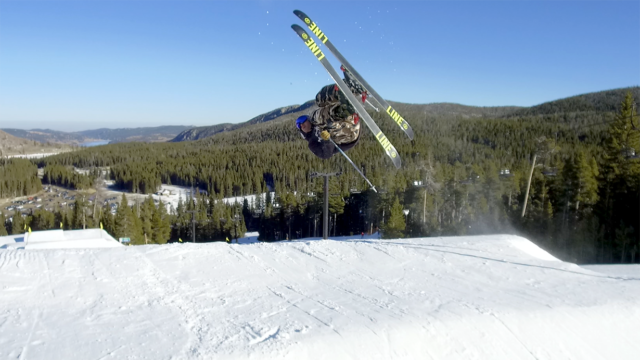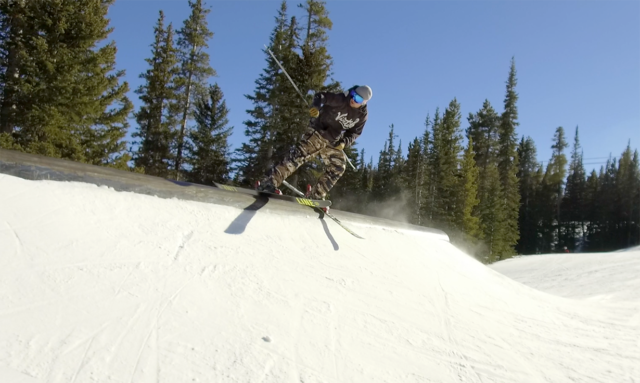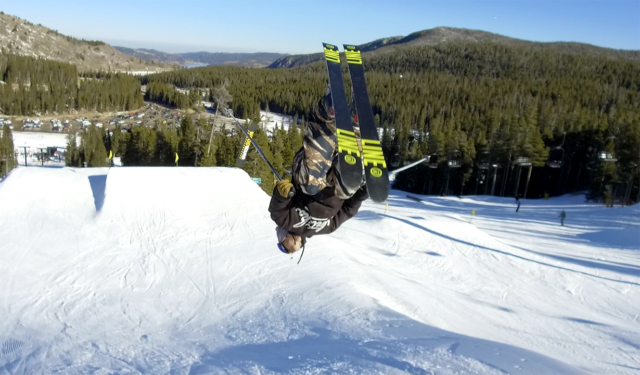 Ski: 2019-2020 Line Tom Wallisch Pro, 178 cm
Ski: 2019-2020 Line Tom Wallisch Pro, 178 cm
Available Lengths: 157, 164, 171, 178 cm
Blister’s Measured Tip-to-Tail Length: 177.1 cm
Stated Weight per Ski: 1802 grams
Blister’s Measured Weight per Ski: 1735 & 1759 grams
Stated Dimensions: 117-90-112 mm
Blister’s Measured Dimensions: 115.6-88.6-112.4
Stated (Avg) Sidecut Radius: 20 meters (avg.)
Tip & Tail Splay (ski decambered): 51 mm / 48 mm
Traditional Camber Underfoot: ~5 mm
Core: Maple/Aspen + Fiberglass Laminate
Factory Recommended Mount Point: -3.25 cm from center; 85.3 cm from tail
Mount Location Tested: Recommended (-3.25 cm from center)
Boots / Bindings: Full Tilt First Chair 8 / Marker Jester Pro
Test Locations: Eldora, Copper, Arapahoe Basin, & Steamboat, CO
Days Skied: 20
[Editor’s Note: Our review was conducted on the 17/18 TW Pro, which was not changed for 18/19 or 19/20, apart from graphics.]
Intro
Tom Wallisch. T-Wall. Todd Walnutz. The Pretzelman.
Whatever name you know him by, no one can deny that Tom Wallisch is one of the best freestyle skiers in the game.
And when the input of such an iconic skier is integrated into a pro model ski, expectations are going to be high.
Line’s description of the ski only adds to the hype, saying that they “pack as much of Tom Wallisch’s personality as physically possible” into this ski, and, “if you’re looking for the most durable high-performance ski that still feels lively, the TW Pro is the ski for you.”
I have been on just about every model of Line park skis over the past 5 years, so I was very excited to see how the TW Pro compared.
Flex Pattern
Here’s how we’d sum up the flex pattern of the TW Pro:
Tips: 5.5-6
Shovels: 6-6.5
In front of Heel Piece: 7.5-8.5
Underfoot: 9.5
Behind Heel piece: 8-7
Tails: 6-5.5
So, the tips and tails are pretty soft, but that flex ramps up a bit, especially behind the heel piece. When hand flexing the TW Pro, Jonathan Ellsworth also noted that its flex pattern felt pretty snappy, especially when compared to the tips and tails of the Line Blend.
Generally, I tend to prefer skis on the softer end of the spectrum in terms of flex, and the TW Pro is a bit stiffer than what I’ve skied in the past (e.g. Line Honey Badger and Chronic). So I was eager to see how the TW Pro felt in terms of its playfulness vs. stability.
Shape / Rocker Profile
The TW Pro, like most of the Line’s park skis, features a rocker / camber / rocker profile. Unweighted and fresh off the shelf, I found the rocker to be pretty minimal. After 20 days riding them, the rocker looks a bit more pronounced.
Similar to the Line Tiger Snake, the TW Pro features Line’s early taper technology in the tip and tail, and Line claims this reduces swing weight and hookiness. Overall, I’d say it’s pretty effective. I found that I could “land” tricks on the TW Pro perpendicular to the mountain, and rather than catch an edge and slam, I had a better chance of riding the rest of the rotation out on the snow. While they’re relatively narrow underfoot at 90 mm, the TW Pro has not felt hooky in the park or in powder, which is impressive.
As for weight, the TW Pro is light without feeling flimsy. The ski’s swing weight feels very low, but the ski still feels substantial and stable. As a result, I felt more confident hitting 40+ ft jumps and carving on ice / hard pack on the TW Pro compared to softer skis. While I’ve felt that a lot of skis with somewhat playful flex patterns also lack torsional stability, the TW Pro seems to keep from twisting at speed and causing slip outs (an issue I’ve had with softer skis).
Jumps
I had a few chances to test out the TW Pro on some of the “L” and “XL” (40-60+ ft) jumps at Woodward Copper, and came away impressed.
While on the TW Pro, I felt very confident both while skiing at speed between kickers and in the air. And while I certainly didn’t stomp anything with Wallisch-level afterbang, I was able to confidently land the tricks (that I’m actually capable of) and ride into the next hit without worrying about skiing at the speed necessary for the next jump.

Grabs and tweaks also felt easy and comfortable, with the ski having just enough weight to keep me aware of their position without requiring much effort to bring them back into place for a landing.
My double front flips, however, still ended in landing zone yard-sales on both attempts, so don’t start thinking that there is magic Wallisch sauce in the TW Pro that will stop you from hitting your face on the ground.
Jibs, Rails, and Other Features
The TW Pro has a sturdy yet surprisingly lively feel underfoot. While I thought the Line Honey Badger felt uncomfortably light at first, the TW Pro felt like it had just enough weight where I could “feel” the skis in the air, but I could still spin them just as easily as the Honey Badger.
I am far from perfect when it comes to spins and swaps, but after a bit of a detune underfoot, I had lots of confidence in my ability to land (and half-land) tricks on features that I would normally be more nervous on. Falling off a rail sidewise or accidentally skimming the TW Pro against a feature while spinning on felt less likely to cause a catastrophic failure than skis with less taper like the Honey Badger or Chronic.
This is one of my favorite characteristics of the TW Pro, as hooking an edge when you ALMOST land a spin off a feature certainly doesn’t inspire the same confidence as kind-of, pretty-much, landing it.

I found that there was a decent sweet spot for pressing the TW Pro. Tip and tail stalls were easier to maintain than with the Honey Badger, but not as easily pressed as the Line Blend or J Skis All Play.
While I found the TW Pro very stable, they still have a nice amount of play to them. I found myself buttering and popping all over the mountain with as much, if not more, confidence than any other ski I’ve used.
Similar to the Honey Badger, the TW is not the best option for long, laid-out butters (grab a pair of Blends if that’s your goal). The TW Pro has a snappy return that likes to pop you up out of a butter, and while I didn’t find this particularly off-putting after riding the Honey Badgers for so long, the TW Pro isn’t going to be the easiest ski to press on features or ride a wheelie down the entire hill. That said, I do think that the TW Pro has a larger butter sweet spot than the Honey Badger, and rotating through a press felt easier because of the gradual flex change and tapered tips.
Outside The Park
After lapping around the Eldora groomers and backside in variable conditions, I think the TW Pro is a solid option for a park ski that still performs pretty well on the rest of the hill.
On fresh-groomed corduroy, I could put down a hard edge at 40+ mph with no jittering or slipping. And while never all that fun, skiing straight ice on the TW Pro was still manageable.
On bumps, they proved to be plenty maneuverable, and the tapered tips seemed to help save me on poorly timed turns.
I would have preferred a wider ski in choppy snow conditions, but the TW Pro didn’t struggle any more than other skis I’ve used in this waist-width category.
While I haven’t had a ton of time on the TW Pro in powder, I did take them out for a few days where we had about 4” of fresh. In light or somewhat-packed powder, the tip and tail shape performed pretty well in terms of not feeling hooky. However, as soon as I got into the deep, untouched 12” of fluff in the trees, the skis sank in pretty deep, and I had to lean back to stay afloat. So, the TW Pro doesn’t float like a powder ski, but for a relatively narrow park ski, it does better than other park skis I’ve used.
Durability
As always, I detuned the edges (directly underfoot only) of the TW Pro before slamming them against any features. And with that usual treatment, the TW Pro is holding up about as well as any pair of park skis I have used. So far, I don’t have any edge cracks, and only have some minor (and typical) chunks missing from the top sheet (mostly in the tails).

The flex of the TW Pro feels very close to how it did on day 1, with perhaps a slight decrease in pop but all the same stability as when I received the ski. The base has also held up well to the usual abuse of park riding.
Who’s It For?
From my experience with Line’s other park skis, I’d say that the TW Pro is probably the brand’s best ski for someone who spends a good amount of their time hitting the larger features in the park, and it’s also more stable than the J Skis All Play and Vishnu Wet. While it’s still playful, the TW Pro doesn’t feel as jib-oriented as the J Skis All Play, Vishnu Wet, Chronic, Honey Badger, or Blend.I can confidently say that the TW Pro is my favorite all-around park ski to date.
While it’s more than adequate out of the park, I wouldn’t recommend buying the TW Pro if you’re mostly looking for an all-mountain ski, and occasionally take a few laps through the park.
It’s also worth noting that the TW Pro comes in at $550, which is very reasonable for a ski of this caliber, and it’s cool to see a “pro model” ski that isn’t outrageously expensive.
Bottom Line
The Line Tom Wallisch Pro is a great ski for pushing yourself to hit larger features in the park, while still maintaining a degree of playfulness that will let you jib around smaller features. It’s the most stable ski Line makes for Large and XL features, yet it still feels pretty versatile, and not something you’d only bring out on big jump days.
Overall, I’ve been extremely impressed by the TW Pro, and feel like I have progressed significantly in my own riding just since starting to test this ski at the beginning of the season. While you may not be stomping tricks with the steeze that’s made Tom a freestyle icon, I think Tom and Line have successfully designed a ski that is up for just about everything you can find in a terrain park.
NEXT: Rocker Profile Pictures

Did you mount these at center or “recommended” ?
Thoughts on the 2023 model as a family groomer / park ski?
Already got all mountain covered with Enforcer 100 and looking for something more playful while skiing with the family at the local bunny hill and park.